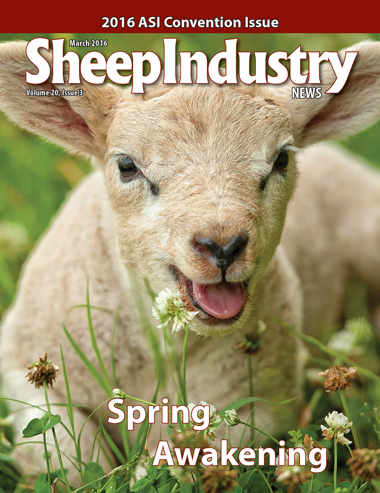
- March 2016
- President’s Notes
- 2016 ASI Convention
- The Strength of a United Voice
- State Execs Benefit from Media Training
- Award Winners Recognized
- Producer Panel Praises EBVs
- PERC Hears Survey Results
- Tips on Preparing for VFD
- Providing Consistent, Quality Lamb
- Let’s Grow Sets New Priorities
- Allotment Records Are Important
- Legislative Council Busy in 2015
- Next Generation Makes Plans
- Arizona Ag Tour
- Optimism For Wool Industry
- Make It With Wool Winners
- Working Dog Liability Insurance
- Seeking Young Producer for Tri-Lamb
- Wolf Testifies on Behalf of Sheep
- Sheep Inventory Up Again
- Use NSIP Data To Improve Lambing Rates
- Market Report
Producer Panel Praises EBVs
KYLE PARTAIN
Sheep Industry News Editor
The Genetics Stakeholders Committee played to a full house during the ASI Convention as industry leaders heard success stories from several producers who have put the National Sheep Improvement Program’s Estimated Breeding Values to use in an effort to improve their flocks.
“We don’t use EBVs to breed a better sheep,” said William “Bill” Shultz of Bunker Hill Farms in Ohio. “We use them to better achieve the goals we have set for our flock.”
Shultz’s presentation centered on two sheep: Top Dog and Fools Gold. A producer seeing the two in the pasture would choose Fools Gold as the superior sheep nearly every time. He easily passed the eye test, but there’s a reason Shultz refers to him as Fools Gold.
While your eyes might deceive you, the numbers on Top Dog don’t lie. His offspring consistently measured better in growth, fat, loin eye and carcass ratings than Fools Gold.
Rams at Bunker Hill Farm showed a dramatic improvement in NSIP’s carcass plus index with Top Dog running the show.
“NSIP provided us with a tool that has become our exclusive selection tool,” Shultz said. “Sure, we still want to see the actual sheep, but we’re even more interested in his carcass plus index.”
Lynn Fahrmeier of Fahrmeier Katahdins in Missouri shared a similar story during the producer’s panel.
Using EBVs, she’s seen a dramatic increase in pounds of lamb weaned per ewe lambing since 2004. She’s also used EBVs to breed sheep that are more resistant to worms – which is of major importance in her part of the country.
“We had an outlier ram that my young son liked,” she said. “He didn’t really start off that great, but he produces ewes that produce a lot of milk and has steadily moved up the charts. Without NSIP, we wouldn’t have realized how good he is. If we can make these kinds of gains, then anyone can.”
Montana’s Betty Sampsel is partial to NSIP’s U.S. range index, which is commonly used by ranchers in the West.
“Without NSIP, we wouldn’t have retained our most influential sire,” she told the group, adding that she’s used the index to identify three lines that were below the flock average.
The committee also heard a report from Ron Lewis, Ph.D., of the University of Nebraska-Lincoln on Melding Genomics and Quantitative Genetics in Sheep Breeding Programs: Opportunities and Limits.

